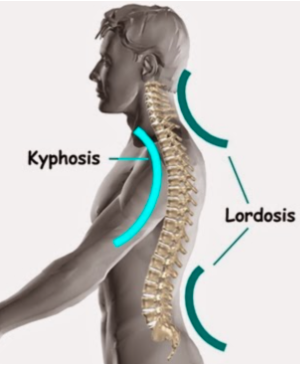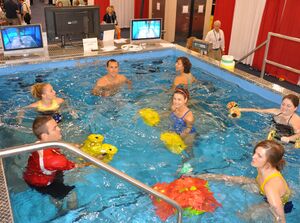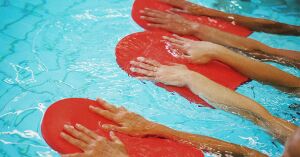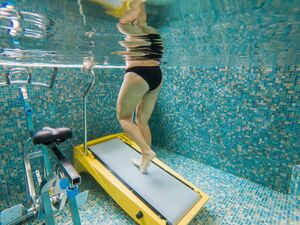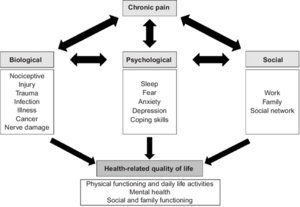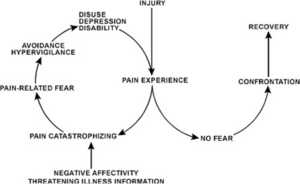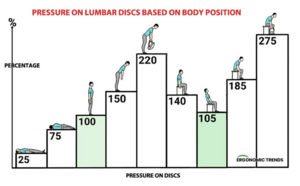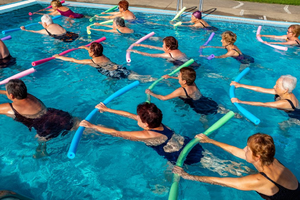Aquatic Therapy in the Management of Chronic Low Back Pain
Top Contributors - Cheung Pak Kuen Eden, Georgina Addison, Reuben Fernandes, Hannah Taplin, Angeliki Chorti, Nicolle Paez, Khloud Shreif and Cindy John-Chu
Introduction[edit | edit source]
Chronic low back pain (CLBP) is a very prevalent condition, affecting millions of people worldwide.[1] It is also one of the leading causes of disability. [2]
Aquatic therapy is a popular treatment modality for those with musculoskeletal and neurological conditions due to the unique properties of water which confer benefits. [3]
Both of these topics are covered separately on Physiopedia pages but have yet to be combined in one page. This page aims to present the research so clinicians can be more informed and potentially offer aquatic therapy as a treatment modality for those with CLBP.
Low Back Pain Classification by Duration:[edit | edit source]
- Acute low back pain: 6 weeks or less
- Sub-acute low back pain: 7-12 weeks
- Chronic low back pain: More than 12 weeks [4]
Chronic Low Back Pain[edit | edit source]
Chronic low back pain refers to pain persisting for longer than three months, even after the initial injury or underlying cause of acute low back pain has been treated. [5][6] There are two further classifications:
Non-specific Low Back Pain is defined as "pain, tension, soreness and/or stiffness in the low back region between the lower margin of the 12th rib and the gluteal folds which is not attributed to any recognisable pathology". [7] Non-specific low back pain affects approximately 90% of all patients with low back pain. [8]
Specific Low Back Pain, these pathologies can be classified as followed: [9]
- Disc herniation
- Spondylolisthesis
- Lumbar muscles or spinal ligament strain/ sprain
- Scoliosis
- Osteoporosis
- Ankylosing spondylitis
- Cauda equina syndrome
- Scheuerman's Kyphosis
Epidemiology[edit | edit source]
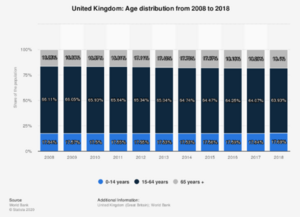
Low back pain (LBP) affects approximately 7.5% of the global population (577.0 million people) of those, 5-10% of all LBP patients will develop CLBP. [11] Specifically, in the United Kingdom, this accounts for 1/3 of all adults and is the leading cause of disability. [12]
In all age groups, the prevalence and number of people living with LBP has continually increased between 1990 to 2017. [13] Even though the prevalence of LBP increases with older age, the greatest number of people with LBP are currently in the 50 to 54 year-old age group. [13]
CLBP is more common in women, those of lower socioeconomic level, people with lower education status, and smokers. The incidence appears to have increased over time. This might be due to significant changes in lifestyle and work environment.[14] A family history of severe back pain, radiating pain, recommendation to rest after a back pain consultation, occupational LBP, or LBP caused by a traffic accident are all linked to chronic disabling back pain over the course of a lifetime. [15] The development of CLBP is also influenced by job satisfaction and psychological variables.
Anatomical Relevance[edit | edit source]
The lumbar spine consists of five lumbar vertebrae (L1-L5). The vertebrae form a slightly inward curve known as lordosis. These vertebrae are connected by facet joints; which allow for lumbar flexion, extension, rotation and lateral rotation.[16]
Lumbar Spine Pathology[edit | edit source]
The lumbar spine's two lowest segments, L5-S1 and L4-L5, bear the greatest weight and move the most, rendering them vulnerable to injury. In between the vertebral bodies, are the intervertebral discs that provide flexibility to the spine, maintaining the height between the vertebrae and distribute compressive loads by acting as shock absorber. As a result of aging, the discs may become less flexible and dehydrated, thus more prone to tearing. [17] This makes them more likely to herniate or degenerate which can cause pain in the low back. Studies also found many patient with CLBP has disc degeneration. [18] The lumbar region also contains large muscles that support the back and allow for movement in the trunk of the body when working together with the abdominal, the gluteal and the leg muscles. These muscles can strain or spasm which is also another common cause of low back pain. [19]
Pathological changes[edit | edit source]
Some studies suggests that para-spinal and multifidus muscle groups are significantly smaller in patients with CLBP than in healthy patients.[20] They believe, patients with persistent unilateral LBP, that this will present on the symptomatic side. [21] These finding can further explain in 2 aspects (Microscopic [22] and Macroscopic [22]).
Microscopic change[edit | edit source]
It has been reported that patient with severe CLBP have a higher portion of type IIB muscle fibre (fast twitch glycolytic) at the expense of type I muscle fibre (slow twitch oxidative). [23] In healthy population, the paraspinal muscles have been found to have more type I muscle fibre in comparison with other skeletal muscle. The alteration in fibre type in severe CLBP, could lead to lowered fatigue resistance of the paraspinal muscles which will result in higher vulnerability of the lumbar spine and cause pain.[24]
Macroscopic change[edit | edit source]
CLBP can affect muscle structure by compromising muscle function. Comprised muscle function due to pain can alter muscle structure, including reduce muscle cross section and increase fat infiltration.[25] Pain-related nerve inhibition reduces lumbar muscle activity in order to prevent tissue damage and lead to muscle inhibition and atrophy.
Clinical Presentation[edit | edit source]
- Dull and achy pain that is contained to the low back region
- Worsening pain after prolonged sitting or standing
- Muscle spasms and tightness in the pelvis, low back and hips
- Burning and "electrical shock" like pain that radiates from the low back to the back of the thighs and/ or the lower extremities
- Difficulty standing up straight, bending and walking [26]
Prognostic Indicators[edit | edit source]
The importance of prognostic factors[edit | edit source]
- By determining which variables are prognostic outcomes, clinicians gain insight on the biology and natural of the disease
- Appropriate treatment strategies may be optimised based on the prognostic factor
- Prognostic factors are often used in the design, conduct and analysis of clinical trials
- Patient and their families are informed about the risk of recurrence or future development of the disease [27]
Prognostic indicators for poor outcomes in CLBP[edit | edit source]
*If odds ratio> 1: odds of exposure among cases is greater than among controls (a positive association between disease and exposure) [28]
| Working status (Active/ not working)
Types of work |
The physical intensity of work, especially strenuous physical work, working in difficult working positions and carrying heavy loads was related to higher chronicity. [29] [30][31] In a case-crossovers study with 12-months follow up, the carrying of heavy loads was predictive for CLBP with an Odds ratio of 8.0 (95% CI 2.8-22.6). [32] |
|---|---|
| Smoking | Smoking has been prove to be major predictor of the chronicity of CLBP. Odd ratio for smoking varied between 2.49 (95% CI 1.15-5.40)and 4.41 (95% CI 1.50-12.95) which showed positive correlation. [33] |
| Obesity | Positive correlation between obesity and chronicity of CLBP. The odd ratio differed between 1.075 (95% CI 1.023-1.128) and 1.21 (95% CI 1.04-1.41) in women and between 1.091 (95% CI 1.027-1.158) and 1.16 (95% CI 1.05-1.29) which showed there are positive correlation. [31][34] |
| Referred leg pain (yes/ no) | LBP with any leg pain tended to be more severe than local LBP only, regardless of how severity was measured, and was also associated with higher frequencies of psychological risk factors. [35] |
| Maladaptive psychosocial factors | Depression was the most studied factor in predicting chronicity. Henschke et al.[36] and Shaw et al. [33]reported statistically significant positive relationship between depression and the chronicity of LBP. |
Main prognostic indicators for the disability of CLBP[edit | edit source]
In a cohort study (n=1760) aiming to identify clinically important prognostic factors of disability in CLBP, younger age, less disability at baseline, shorter duration of back complaints at baseline, and higher baseline scores on the SF-36 Physical component Summary and Mental Component Summery were reported as predictors of absolute recovery (Quebec Back Pain Disability Scale score ≤20 points) at both 5- and 12-month follow-ups. [37]
Main prognostic indicators for the chronicity of CLBP[edit | edit source]
A recent systematic review of 25 studies reported that high pain intensity, carrying heavy loads at work, higher body weight and depression were the most frequently observed risk factors for CLBP. Maladaptive behaviour strategies, general anxiety, functional limitation during the episode, smoking, and particularly physical work were also explicitly predictive of chronicity. [38]
Aquatic Therapy[edit | edit source]
What is Aquatic Therapy?[edit | edit source]
Aquatic therapy can be defined as “A physiotherapy programme utilising the properties of water, designed by a suitably qualified physiotherapist”.[39] This treatment method involves various exercises in water which should be carried out by appropriately trained therapists in a heated, purpose-built hydrotherapy pool.
The use of aquatic therapy is popular amongst patients with musculoskeletal and neurological disorders. [3] Patients report benefits of increased strength, flexibility, mobility, as well as decreased pain levels.[40]. These benefits are resultant of the unique properties of water, and therefore cannot always be replicated through land-based exercise.
Unique Properties of Water[edit | edit source]
Water Density[edit | edit source]
The water density counterbalances the effect of gravity which allows the human body to float. This buoyancy effect offers support allowing less impact on joints. This is valuable during rehabilitation as it allows patients who are experiencing pain, to exercise with reduced loading through the joints. Additionally, this buoyancy effect controls the downwards movement of the body and therefore decreases the need for eccentric control. [41]
Exercises such as walking, jogging, or running which may be painful to patients, can now be performed in water with less impact on the joint and therefore less pain. For spinal patients this causes reduced axial loading and joint stress on the spine.
Natural Resistance of Water[edit | edit source]
Water has a natural resistance as a result of its density and viscosity. This allows for effective strengthening during rehabilitation treatment sessions. The intensity of the resistance can be manipulated as well to fit the individual needs of the patient. Altering depth of submergence, speed of exercises performed, and the surface area of the body can affect the resistance profile of the water. For example, when stationary there is less resistance from the water on the body. However, during high-speed movements, the resistance from the water will increase. Therefore, high speed resistance training can be performed in water allowing for strength to be built with low impact on the joints. As a result, aquatic therapy can be used as an alternative to land-based strength exercise. [41]
Water as a Compressor[edit | edit source]
When a patient is submerged in water, they are subjected to hydrostatic pressure. This pressure has resultant effects on the body. For example, increased blood flow and circulation. This allows for greater oxygen delivery to the muscles and relaxation. Hydrostatic pressure can also compress the chest wall which alters pulmonary function and respiratory dynamics. As a result, work of breathing is increased by around 60% compared to that on land. This can actually strengthen respiratory muscles and improve the aerobic fitness of individuals. [41]
Temperature[edit | edit source]
Hydrotherapy pools are usually heated to between 28-32 degrees Celsius. When submerged, this warm pool temperature can increase blood flow and range of motion. It can also produce greater muscle elasticity which can be beneficial for patients experiencing tightness of the muscles, stiffness or spasticity.[41]
Indications, Contraindications and Precautions to Aquatic Therapy[edit | edit source]
Indications[edit | edit source]
- Management of muscle tone problems
- Decreased range of movement
- Decreased muscle strength
- Reduced balance
- Joint instability
- Pain
- Gait re-education
- Decreased sensation
- Neurological patients
- Patients who are willing to self-manage through a water-based exercise programme which they can continue with in pools available in leisure centres
- Patients who would benefit from aquatic physiotherapy in the short-term to then progress to land-based exercise when ready [42]
This would include conditions such as:
- Fibromyalgia
- Hemiplegia
- Cerebral palsy
- Ankylosing spondylitis
- Juvenile idiopathic arthritis
- Parkinson’s Disease
- Obesity
- CLBP
- Multiple sclerosis
- Traumatic brain injuries
- Stroke
- Rheumatoid arthritis
Contraindications[edit | edit source]
Absolute Contraindications[edit | edit source]
Patients with the following are not suitable to receive aquatic physiotherapy:
- Acute systemic illness/pyrexia
- Acute vomiting or diarrhoea
- Medical instability following an acute episode e.g., CVA, DVT
- Chlorine or bromine allergy
- Resting angina
- Shortness of breath at rest
- Uncontrolled cardiac failure
- Open infected wounds [43][44]
Relative Contraindications[edit | edit source]
- Known aneurysm
- Poorly controlled epilepsy
- Open wounds
- Thyroid deficiency
- Neutropenia
- Weight in excess of evacuation equipment limit
- Oxygen dependency
- Unstable diabetes – blood sugar may drop [43] [44]
Precautions[edit | edit source]
- Incontinence of urine/faeces
- Epilepsy
- Hypotension
- Renal failure
- Poor skin integrity
- Risk of aspiration
- Prone to blackouts
- Sickle cell anaemia
- Tracheostomy
- Fear of water
- Pregnancy is water temperature exceeds 35°C
- Low calorie intake
Equipment Used in Aquatic Therapy[edit | edit source]
Resistance Aids[edit | edit source]
- Flippers/fins
- Aquatic Dumbbells
- Wrist and Ankle Weights
- Submersible Steps
Floatation Aids[edit | edit source]
- Pool Noodles
- Aqua round body support
- Floatation Belts
- Arm Bands
- Kick boards
- Aqua Plinth
- Sensafloat
Cardiovascular Equipment[edit | edit source]
- Underwater Treadmill
- Underwater Stationary bike
Benefits of Aquatic physiotherapy[edit | edit source]
- Improved flexibility
- Improved balance
- Improved physical function
- Increased muscle strength and endurance
- Enhanced aerobic capacity
- Relaxation
- Increased mobility
- Decreased pain levels
- Improved Quality of Life
Assessment and Diagnosis[edit | edit source]
During the initial assessment, as recommended in the international back pain guidelines, it is important to examine the patient to diagnostically triage their presenting condition. [54] This includes screening patients with any new onset of back pain for red flag diagnosis (i.e. neurologic compromise, inflammatory disease, infection, trauma/ fractures, and cancer which may require emergency attention). [55]
Additionally, it is important to identify other pathology or non-specific causes of back pain. NICE guidelines recommends considering using risk stratification such as the STarT Back risk assessment at first point contact for any new episodes of LBP (with or without sciatica) for shared decision-making. [55]
Subjective History[edit | edit source]
Undertaking a subjective history allows to build a rapport with your patient, gain a further insight into their LBP such as onset, duration, location, character, severity and aggravating and relieving factors in addition to identifying serious pathologies.
Physical Assessment[edit | edit source]
A physical assessment will follow the subjective history to clinically reason and confirm hypothesis. A physical assessment for the lower back will include the following:
- Observation – posture, abnormal deformity, and curvature
- Palpation – along spinous process and transverse process, musculature, sacroiliac joint
- Gait – through stance and swing phase
- Range of Motion – Passive and Active of lumbar, thoracic spine, and hip
- Muscle strength – Lumbar spine and Hip
- Neurological testing – Reflexes, Motor and sensory testing, straight leg raise, femoral nerve test
- Testing SIJ and Hip – thigh thrust test, pelvic compression, FABER’s
- Motor control testing – Waiter’s Bow, Pelvic tilts
- Imagining is not routinely offered in non-specialist setting for people with low back pain – NICE
Patient-reported outcome measures[edit | edit source]
Using patient-reported outcomes provides a patient's perceptive of their disease and treatment which we may not be able to gain through the subjective and objective assessment. It allows patients to track their progress, measure quality of care and management and provides motivation and adherence to treatment. [56] [57][58]
In a 2016 Delphi survey [59] which included an international multidisciplinary group of researchers, clinicians and patients updated the set outcome domains for LBP. These domains are mentioned below with the associated outcome measures with the best psychometric properties.
Choosing the domain and outcome measure during clinical assessment will depend on various different factors such as the patient's level of function, disability and goals. It is recommended to use one of these measures due to reasons mentioned above considering the practitioners personal preference, practical aspects e.g. costs and availability [58]
- Physical function – Oswestry Disability Index or Roland Morris Disability Questionnaire
- Pain intensity – Numerical Rating Scale or Visual Analogue Scale
- Health-related quality of life – Short Form Health Survey 12 or EuroQol-5D-3L
- Work – Work Ability or Work productivity questionnaire
- Psychological functioning – Hospital Anxiety and Disability Scale
- Pain interference – Pain Interference subscale of the Brief Pain Inventory
Psychosocial Effects of Chronic Low Back Pain[edit | edit source]
Background[edit | edit source]
Known predictors of chronicity and disability in patients with LBP include; depression, distress, and somatisation. [60] Psychological factors that are associated with all chronic pain include depression and anxiety, fear avoidance, low self-efficacy, and post-traumatic stress disorder [60] [61] [62]. Finally, social factors include abstaining from work, detaching and isolating from others and compensatory mechanisms. [60]
The Biopsychosocial Model of Chronic Pain[edit | edit source]
Numerous psychosocial factors are associated with CLBP, therefore a biopsychosocial perspective is important to provide optimal care. [63] The biopsychosocial model of back pain is based on a holistic view which recognises the reciprocal influences of the biological, psychological, and social variables that influence LBP. Due to the variable human experiences of back pain, this is vital to understand. [64] Demonstrated in the image below.
- Bio: physiological pathology
- Psycho: behaviours, thoughts and emotions such as psychological distress, fear/avoidance beliefs, current coping methods and attribution
- Social: socio-economical, socio-environmental, and cultural factors such as work and family
Duenas [65] explains that chronic pain causes significant consequences for not only patients but their professional and social environment and therefore both social and psychological domains are important to understand. [65]
Psychosocial Factors Influence Ones' Life[edit | edit source]
Psychosocial factors cause a continuous detrimental cycle whereby they not only affect the back pain but also one’s life. For example, depressive symptoms may worsen back pain and therefore increase the disability associated with back pain. [63]
Back pain patients are more likely to experience:
- Anxiety disorders
- Major depressive disorders
The coexistence of these conditions and associated back pain may lead to decreased quality of life and a greater chronicity. Despite this, mechanisms of the associations that underly CLBP are still not fully understood. [66]
Avoidance Behaviour - Anxiety[edit | edit source]
There are two pathways in which people may take when experiencing LBP. The first is that they continue their daily life by moving normally, which intern helps the recovery process. However, the other pathway evolves when a patient begins to avoid movements, potentially due to pain-related fear, anxiety, or to seek safety. This can lead to cycles of greater disability and increasing pain, and thus the maintenance of chronic pain. This is described in the Fear Avoidance and Beliefs Model (FAMB). [67]
Low Back Pain and Depression[edit | edit source]
A study by Robertson [68] with 1013 first year Canadian university students looked at the association between LBP and depression and somatisation in adults. Participants completed the modified Zung Depression Index, the modified somatic perception questionnaire and a survey about low back pain and intensity. Results revealed over 50% of subjects reported LBP across grades, and both depression and somatisation was positively associated with LBP, consistent with other studies and reinforcing the understanding of the detrimental association. [68]
Summary[edit | edit source]
The deleterious cycle of psychosocial factors and CLBP impact many people worldwide. Psychosocial factors not only impact back pain but also play a role in how the pain impacts one's life. Therefore, it is important to be aware of the psychosocial element that plays such a huge role in the assessment, management and treatment of LBP. For example, use psychosocial outcome measures with patient to measure their current presenting condition and improvements (HADS), as discussed previously.
The Effectiveness of Aquatic Therapy for Chronic Low Back Pain[edit | edit source]
The standardised approach for the management of CLBP is multi-modal. The NICE guidelines recommend: [55]
- Self-management
- Advice and information from health care professionals to allow patients to self-manage their pain
- Activity modification
- Information about the nature of their back pain
- Advice and information from health care professionals to allow patients to self-manage their pain
- Exercise
- Type of exercise should take into account the patients' specific needs, preferences and capabilities
- Group exercise programmes are recommended
- Manual Therapy
- Spinal Manipulation, mobilisation and soft tissue techniques in addition to exercise
- Psychological therapy
- CBT approach for managing LBP in addition to exercise
- Consider a combined physical and psychological programme
- Promote and facilitate return to work and normal activities
- Pharmacological approach
- Oral NSAIDs
- Lowest effective dose for the shortest amount of time
- Weak opioids if NSAIDs are contraindicated
- Oral NSAIDs
Within these NICE guidelines the importance is placed upon exercise and making sure the type of exercise takes into account the specific needs and preferences of the individual patient. Often, patients are prescribed land-based exercises focusing on strengthening, stretching and motor control.
However, when walking or moving on land, our spine gets compressively loaded due to gravity and body positions which can increase intradiscal pressure. [69][70] This is important to note because increased of loading of the facet joints, and other spinal structures has been suggested as a potential cause LBP. [71]
This is why it is important to consider alternative treatment options to land-based exercise which decrease this spinal loading. For example, aquatic therapy can be indicated as a management option for CLBP because the unique properties of water allow for exercise in a medium which reduces pressure on joints.
The main benefits of aquatic therapy for CLBP are:
- Decreased Pain
- Increased Function
- Decreased Disability
Aquatic therapy for improving pain[edit | edit source]
As previously stated, aquatic therapy can have benefits for CLBP by decreasing patients self-reported pain levels. In research, this is often measured using visual analogue scales (VAS).
A randomised control trial by Baena-Beato et al.[72] researched the effect aquatic therapy had on sedentary patients with CLBP. The 49 participants were split into aquatic therapy and waiting list groups who received advice and education (control). Results found that after 2 months of the aquatic therapy programme, participants experienced significantly improved LBP (VAS) at rest, and lumbar flexion and extension compared to the control group. Body composition was also measured, with weight and BMI decreasing for the aquatic therapy group compared to the control. However, this was a small sample size and only evaluated sedentary patients which could impact the generalisation of these results to the wider population.
Aquatic therapy decreasing pain for patients with CLBP has been supported by a systematic review and meta-analysis Shi et al.[73] This review included 8 trials with a total of 331 participants, looking at the effectiveness of aquatic therapy for CLBP patients. Sessions ranged from 2-5x a week and from 30-80-minute sessions over a period of 4-15 weeks. Comparison groups either received land-based therapy, standard general practice, or no exercise. Results showed that patients who took part in aquatic therapy experienced a statistically significant reduction in self-reported pain (VAS) compared to the control groups. However, these changes were not always reported as clinically significant.
Aquatic therapy for improving disability and function[edit | edit source]
CLBP is one the leading cause of disability worldwide.[2] As a result, physical function is compromised, and patients often struggle to complete their activities of daily life and work-related activities.
Aquatic therapy aims to improve these two symptoms of CLBP.
A randomised control trial by Dundar et al.[74] assessed 65 patients with CLBP. They were randomly assigned aquatic exercise or land-based exercise. After 4 weeks, both groups improved in all outcome measures compared to baseline. However, the aquatic exercise group showed a significantly better improvement in the Oswestry Low back pain disability questionnaire and the physical function section of the SF36.
This was further supported by a systematic review. [75]A total of 7 trials were included in the review, and results showed that compared to no intervention, aquatic therapy resulted in a significant improvement in function (Oswestry Disability index). However, the improvements were no better than other interventions.
Aquatic Therapy vs Other Therapies[edit | edit source]
Land-based therapy is recommended for patients with LBP as an intervention to increase range of motion, flexibility, and strength. As mentioned above, aquatic therapy has a wide range of benefits on patients with LBP.
Here are two studies comparing aquatic and land-based therapy for patients with LBP:
A study by Hend et al. [76] conducted a randomised control trial comparing aquatic therapy (n=30) to land-based therapy (n=30) on pain level, functional ability, and lumbar range of motion in CLBP patients. In a population of 60 participants, on multivariate analysis, a statistically significant multivariate effects were found for the main effects of groups for time and interaction between groups and time. Additionally, on univariate analysis, a statistically significant difference (p<0.05) between the groups were observed, favouring the aquatic group for VAS, ODI, flexion, extension, and side flexion outcome after 4 weeks. Land-based exercises did show statistical improvements in pain intensity, ODI and lumbar flexion however no difference was observed in extension and right and left side flexion with aquatic therapy group showing significant results in all outcome measures. However, this study had no control group and did not evaluate the long-term effects of using water-based therapy therefore could have been impacted by bias reducing its validity and reliability.
Another randomised control trail by Peng et al. [77] compared aquatic therapy to physical activity modalities (TENS). In a population of 113 participants, they were split into aquatic group (56) and physical therapy modalities group (57). After treatment for 12 weeks, which comprised to 60-minute sessions twice per week for a total of 24 sessions, a statistically significant clinically meaningful improvement was observed in disability scores (Roland Morris) in the aquatic group compared to physical modalities after 3, 6 and 12 months (p<0.001). In addition, there was significant improvement in pain rating at 3,6 and 12 months in the aquatic group compared to physical modalities (p<0.001). However, this study had no control group, increasing risk of bias and were unable to determine if benefits were from an active warm-up thus reducing validity.
On the other hand, a study by Nemcic et al. [78] demonstrated no significant difference between an aquatic therapy group and land-based group after a 3 week programme in lumbar mobility and physical disability demonstrating either modality is modality is beneficial in managing LBP.
Psychosocial Effects of Aquatic Therapy on Chronic Low Back Pain[edit | edit source]
Introduction[edit | edit source]
There are numerous psychosocial benefits from engaging in aquatic physiotherapy and recent research explains that all aquatic exercise is vital in promoting and managing mental health. Firstly, partaking in physical exercise can have many positive effects on quality of life due to the facilitation and promotion of social interaction. [79] [80] [81] On the other hand, psychosocial stressors and a sedentary lifestyle has been shown to reduce cellular functioning. Thus, promoting physical exercise is vital when treating and preventing depression [82] and other mental health disorders.
Psychosocial benefits[edit | edit source]
- Stress relief
- Relaxation of muscles
- Water is associated with fun and relaxation
- Promotes body awareness
- Increases self-efficacy and confidence
The warm water and physical properties of water (buoyancy and hydrostatic pressure) can provide stress relief allowing the muscles to relax, leading to tension relief and a reduction in muscle spasms, [83] promoting a less anxious state. Women partaking in aquatic physiotherapy report feeling comfortable and relaxed in the warm water. [84]
Additionally, aquatic therapy can provide a sense of control and understanding of your own body due to the hydrostatic pressure promoting sensory receptors, allowing patients to take back control of their own movements, increasing self-efficacy and confidence. [85]
Aquatic physiotherapy, depression and quality of life[edit | edit source]
Silva [81] completed a study with 30 elderly participants to determine the effects of aquatic exercise on mental health. The participants were allocated into two groups (depression group and non-depression group) in which they completed an aquatic exercise programme for 12 weeks. They discovered that, in depressed elderly individuals, aquatic physiotherapy reduces depression and anxiety, improves activities of daily living, and reduces oxidative stress.
A clinical trial of sedentary adults with CLBP by Beato, [86] examined the prognostic factors and disability change after a two-months intensive aquatic therapy programme compared to the control group. They discovered among others changes that quality of life improved. Suggesting an improvement in the patients psychosocially after an aquatic physiotherapy programme.
Swim England Supports Aquatic Physiotherapy[edit | edit source]
Swim England’s 2019 Value of Swimming report and the 2021 Decade of Decline report were both created to encourage and improve the awareness of swimming and aquatic therapy. Their overall aim is to prevent the closures of hydrotherapy pools. They report that this is because of the positive impact aquatic physiotherapy can have on one's physical and mental well-being. [87]
The video below was made by Swim England, and shares Dominic's story, who has cerebral palsy and has been in a wheelchair most of his life. Dominic says "I can walk by myself, swim by myself, just do everything in the water by myself, it really promotes my independence.” [87]
“I think the main impact that aquatic physiotherapy has had on Dom is that it has both physical, physiological and psychosocial benefits." - Jacqueline Pattman. [87]
Aquatic Physiotherapy Prescription[edit | edit source]
As previous studies have shown, aquatic physiotherapy can be proven useful for reducing symptoms of CLBP. However, the question remains as to how frequent this intervention needs to take place for it to be effective in the short and long-term.
Frequency Per Week[edit | edit source]
There are a couple studies which look at the effect of different frequencies for this intervention. For example, Baena-Baeato et al.[88] compared the effect of completing aquatic therapy either 2x or 3x a week for CLBP patients over an 8-week period. This study included 54 participants who had CLBP for more than 12 weeks. They were split into a control group (education/advice only), aquatic therapy 2x a week and then aquatic therapy 3x a week. Outcome measures of pain, disability, quality of life, body composition and health related fitness were used to determine the effects of the different frequencies. Results showed that both groups experienced significant improvements in back pain and disability compared to the control group. However, the 3x a week group showed significantly greater benefits with pain into flexion and disability levels compared to the 2x a week group. Both groups experienced significantly improved quality of life and health related parameters. There were no significant changes between the treatment groups and control in regard to body composition.
Another study [89] investigated the optimal frequency of aquatic therapy for individuals with chronic musculoskeletal pain. This randomised control trial included 114 people with chronic musculoskeletal pain and had them participate in aquatic therapy either 2x or 3x a week for a year. Patients included experienced 1 of 3 musculoskeletal disorders: chronic lower back pain, chronic neck pain or osteoarthritis. Outcome measures included quality of life, disability index and WOMAC for OA patients. Measurements were taken at baseline, 8 weeks, 6 months and a year after the programme started. Results showed that there were no statistical differences between the two groups except the neck disability index at 8 weeks. There were improvements for all groups and all variables from baseline to a year.
Length of Session and Content of Session[edit | edit source]
Both studies [88] [89]included aquatic therapy sessions which were on average 60 minutes long. This is consistent with other studies which look generally at the effectiveness of aquatic therapy on CLBP. For example, in a systematic review, [53] 13 studies were reviewed, and the majority used interventions of aquatic therapy ranging from 45-60 minutes. Aquatic therapy sessions included warmups, muscle strength exercises, aerobic exercises and cool downs working on flexibility. This systematic review concluded that aquatic therapy improved pain, disability, and quality of life.
What the Evidence Suggests[edit | edit source]
As a result of these studies, it can be concluded that the optimal aquatic therapy prescription for CLBP patients should be 2x a week for 60-minute sessions. These sessions should include a mixture of aerobic and resistance exercises as well as a warmup and cool down. This knowledge has implications for rehabilitation, as it shows that 2x a week is often comparable to 3x a week of aquatic therapy for outcomes of CLBP. This can save resources and cost for patients and service providers without compromising the effects of the treatment.
Conclusion[edit | edit source]
CLBP is a highly common health issue within the population. It is a complex condition which has both biological and psychosocial components which need to be considered. As a result is important to investigate different treatment interventions on all of these components, measured by relevant outcome measures. Aquatic therapy has been proven to have extra benefits from land based training due to the unique properties of water, hence the decision to investigate the effect of this treatment on chronic low back pain.
Literature has demonstrated multiple benefits of aquatic therapy in CLBP. These benefits include a decrease in pain levels and improvements in disability and function. Additionally, aquatic therapy has been shown to have psychological benefits which include improvements in self efficacy, confidence and anxiety/depression for patients with CLBP.
However, it is important to consider the limitations present within the studies when considering treatment options as currently there is not sufficient comprehensive research to suggest aquatic therapy is superior over land based exercise. Despite this, it is noteworthy that aquatic therapy can provide similar benefits to land based exercise with the addition of relaxation from the warm water. The choice of intervention for chronic low back pain should be based upon individual assessment and preference of therapist and/or patient.
References[edit | edit source]
- ↑ Wu A, March L, Zheng X, Huang J, Wang X, Zhao J, Blyth F, Smith E, Buchbinder R, Hoy D. Global low back pain prevalence and years lived with disability from 1990 to 2017: estimates from the Global Burden of Disease Study 2017. Ann Transl Med. 2020 Mar;8(6):299–9.
- ↑ 2.0 2.1 Hartvigsen J, Hancock MJ, Kongsted A, Louw Q, Ferreira ML, Genevay S, Hoy D, Karppinen J, Pransky G, Sieper J, Smeets RJ, Underwood M; Lancet Low Back Pain Series Working Group. What low back pain is and why we need to pay attention. The Lancet. 2018 Jun;391(10137):2356–67.
- ↑ 3.0 3.1 Castro-Sánchez AM, Matarán-Peñarrocha GA, Lara-Palomo I, Saavedra-Hernández M, Arroyo-Morales M, Moreno-Lorenzo C. Hydrotherapy for the Treatment of Pain in People with Multiple Sclerosis: A Randomized Controlled Trial. Evid Based Complement Alternat Med. 2012;2012:473963.
- ↑ Burton AK, Balagué F, Cardon G, Eriksen HR, Henrotin Y, Lahad A, Leclerc A, Müller G, van der Beek AJ; COST B13 Working Group on Guidelines for Prevention in Low Back Pain. Chapter 2. European guidelines for prevention in low back pain. Eur Spine J. 2006 Mar;15 Suppl 2(Suppl 2):S136-68.
- ↑ Cedric B, Huec J. Chronic low back pain: Relevance of a new classification based on the injury pattern. Orthop Traumatol Surg Res 2019; 105(2): 339–46.
- ↑ Vrbanić, T.S.-L. Low back pain--from definition to diagnosis. Reumatizam. 2011; 58(2):105–7. [Article in Croatian]
- ↑ Burton AK, Tillotson KM, Main CJ, Hollis S. Psychosocial predictors of outcome in acute and subchronic low back trouble. Spine. 1995 Mar 15;20(6):722-8.
- ↑ Kahere M, Ginindza T. The burden of non-specific chronic low back pain among adults in KwaZulu-Natal, South Africa: a protocol for a mixed-methods study. BMJ Open 2020; 10(9):e039554.
- ↑ Koes BW, Van Tulder MW. Clinical Review: Diagnosis and treatment of low back pain. BMJ. 2006;332:1430.
- ↑ Davidson K. Lower Back Pain is Increasing in Prevalence. What are the Reasons? Buxton Osteopathy Clinic. 2020 Available from: https://buxtonosteopathy.co.uk/blog/why-is-the-prevalence-of-lower-back-pain-increasing/ [accessed 27/5/2023].
- ↑ Meucci RD, Fassa AG, Faria N. Prevalence of chronic low back pain: systematic review. Rev Saude Publica. 2015 Oct 20;49:73.
- ↑ Macfarlane GJ, Beasley M, Jones EA, Prescott GJ, Docking R, Keeley P, McBeth J, Jones GT; MUSICIAN study team. The prevalence and management of low back pain across adulthood: results from a population-based cross-sectional study (the MUSICIAN study). Pain 2012; 153(1): 27-32.
- ↑ 13.0 13.1 Wu A, March L, Zheng X, Huang J, Wang X, Zhao J, Blyth F, Smith E, Buchbinder R, Hoy D. Global low back pain prevalence and years lived with disability from 1990 to 2017: estimates from the Global Burden of Disease Study 2017. Ann Transl Med. 2020; 8(6):299.
- ↑ Fujii T, Matsudaira K. Prevalence of low back pain and factors associated with chronic disabling back pain in Japan. Eur Spine J. 2013 Feb;22(2):432-8.
- ↑ Valmira NL, Miftari S. Manual Therapy and Exercise Therapy in Patients with Chronic Low Back Pain. Research in Physical Education, Sport & Health. 2019 Jan 1;8(1).
- ↑ Standring S Gray's Anatomy, The Anatomical Basis of Clinical Practice.40th edn. London: Churchill Livingstone Elsevier, 2008; 749–761.
- ↑ Navanaugh JM, Ozaktay AC, Yamashita HT, King A. Lumbar facet pain: biomechanics, neuroanatomy and neurophysiology. J Biomech. 1996;29(9):1117–29.
- ↑ Luoma, K, Riihimäki H, Luukkonen R, Raininko R, Viikari-Juntura E. Lamminen A. Low Back Pain in Relation to Lumbar Disc Degeneration. Spine. 2000; 25(4):487–92.
- ↑ Allegri M, Montella S, Salici F, Valente A, Marchesini M, Compagnone C, Baciarello M, Manferdini M, Fanelli G. Mechanisms of low back pain: a guide for diagnosis and therapy. F1000Res. 2016; 5(91 51):1530.
- ↑ Fortin M, Macedo LG. Multifidus and Paraspinal Muscle Group Cross-Sectional Areas of Patients With Low Back Pain and Control Patients: A Systematic Review With a Focus on Blinding. Phys Ther. 2013; 93(7):873–8.
- ↑ Kim W, Lee S-H, Lee D. Changes in the Cross-Sectional Area of Multifidus and Psoas in Unilateral Sciatica Caused by Lumbar Disc Herniation. J Korean Neurosurg Soc. 2011; 50(3):201.
- ↑ 22.0 22.1 Goubert D, Danneels L, Cagnie B, Van Oosterwijck J, Kolba K, Noyez H, Meeus M. Effect of Pain Induction or Pain Reduction on Conditioned Pain Modulation in Adults: A Systematic Review. Pain Practice. 2014; 15(8): 765–7.
- ↑ Mannion AF. Fibre type characteristics and function of the human paraspinal muscles: Normal values and changes in association with low back pain. J Electromyogr Kinesiol. 1999; 9:363-377.
- ↑ Crossman K, Mahon M, Watson PJ, Oldham JA, Cooper RG. Chronic low back pain-associated paraspinal muscle dysfunction is not the result of a constitutionally determined adverse fiber-type composition. Spine. 2004; 29:628-34.
- ↑ Falla D, Farina D. Neuromuscular adaptation in experimental and clinical neck pain. J Electromyogr Kinesiol. 2008;18:255-61.
- ↑ Shambrook J, McNee P, Harris EC, Kim M, Sampson M, Palmer KT, Coggon D. Clinical presentation of low back pain and association with risk factors according to findings on magnetic resonance imaging. Pain. 2011;152(7):1659–65.
- ↑ Nieminen L, Pyysalo L, Kankaanpääa M. Prognostic factors for pain chronicity in low back pain: a systematic review. Pain Rep. 2021; 6(1): e919.
- ↑ Persoskie A, Ferrer R. A Most Odd Ratio. Am J Prev Med. 2017; 52(2):224–8.
- ↑ Esquirol Y, Niezborala M, Visentin M, Leguevel A, Gonzalez I, Marquié J.-C. Contribution of occupational factors to the incidence and persistence of chronic low back pain among workers: results from the longitudinal VISAT study. Occup Environ Med. 2016; 74(4):243–51.
- ↑ Herin F, Vézina M, Thaon I, Soulat J.-M, Paris C. Predictive risk factors for chronic regional and multisite musculoskeletal pain: A 5-year prospective study in a working population. Pain. 2014; 155(5):937–43.
- ↑ 31.0 31.1 Heuch I, Heuch I, Hagen K, Zwart J.-A. Physical activity level at work and risk of chronic low back pain: A follow-up in the Nord-Trøndelag Health Study. PLoS One. 2007 12(4):e0175086.
- ↑ Machado G, Ferreira P, Maher C, Latimer J, Steffens D, Koes B, Li Q, Ferreira M. Transient physical and psychosocial activities increase the risk of nonpersistent and persistent low back pain: a case-crossover study with 12 months follow-up. Spine J. 2016;16(12):1445–52.
- ↑ 33.0 33.1 Shaw W, Means-Christensen A, Slater M, Webster J, Patterson T, Grant I, Garfin S, Wahlgren D, Patel S, Atkinson J. Psychiatric Disorders and Risk of Transition to Chronicity in Men with First Onset Low Back Pain. Pain Med. 2010;11(9):1391–1400.
- ↑ Heuch I, Heuch I, Hagen K, Zwart J.-A. A Comparison of Anthropometric Measures for Assessing the Association between Body Size and Risk of Chronic Low Back Pain: The HUNT Study. PLoS One. 2015; 10(10):e0141268.
- ↑ Kongsted A, Kent P, Albert H, Jensen T, Manniche C. Patients with low back pain differ from those who also have leg pain or signs of nerve root involvement – a cross-sectional study. BMC Musculoskel Dis. 2012; 13(1):236.
- ↑ Henschke N, Maher CG, Refshauge KM. Prognosis in patients with recent onset low back pain in Australian primary care: inception cohort study. BMJ 2008 Jul 7;337(7662):a171.
- ↑ Verkerk K, Luijsterburg P, Heymans M, Ronchetti I, Pool-Goudzwaard A, Miedema H, Koes B. Prognosis and Course of Disability in Patients With Chronic Nonspecific Low Back Pain: A 5- and 12-Month Follow-up Cohort Study. Phys Ther. 2013 93(12):1603–14.
- ↑ Nieminen L, Pyysalo L, Kankaanpää M. Prognostic factors for pain chronicity in low back pain: a systematic review. Pain Rep. 2021; 6(1):e919.
- ↑ Aquatic Therapy Association of Chartered Physiotherapists. About ATACP Available from: https://atacp.csp.org.uk/content/about-atacp [accessed 25/6/2023]
- ↑ Larmer P, Kersten P, Dangan J. Patient reported benefits of hydrotherapy for arthritis. New Z J Phys. 2014;42(2):89-93.
- ↑ 41.0 41.1 41.2 41.3 Torres-Ronda L, Schelling I del Alcázar X. The Properties of Water and their Applications for Training. J Hum Kinet. 2014 Dec 30;44(1):237–48.
- ↑ Schitter AM, Fleckenstein J, Frei P, Taeymans J, Kurpiers N, Radlinger L. Applications, indications, and effects of passive hydrotherapy WATSU (WaterShiatsu)—A systematic review and meta-analysis. PLoS One. 2020 Mar 13;15(3):e0229705.
- ↑ 43.0 43.1 Welsh Physiotherapy Advisory Group. All Wales Evidence Based Guidance for Access to Hydrotherapy for NHS Patients in Wales/ WPhLAG/ Vers 3. December 2016. Available from: https://www.csp.org.uk/system/files/documents/2018-07/wphlag_guidance_for_provision_of_hydrotherapy_to_nhs_patients_in_wales_final.pdf [accessed 25/6/2023]
- ↑ 44.0 44.1 ATACP. Guidance on Good Practice in Aquatic Physiotherapy 2015 Version 1.1 Available from: https://atacp.csp.org.uk/system/files/documents/2018-08/completed_purchase [accessed 25/6/2023]
- ↑ EWAC Medical. Hydrotherapy equipment, an important tool within rehabilitation. 2019. Available from: https://www.ewacmedical.com/hydrotherapy-equipment-rehabilitation/ [accessed 25/6/2023]
- ↑ Hydrotherapy Peterborough. Equipment List - St George’s Hydrotherapy Pool. Available from: http://www.hydrotherapypeterborough.com/shared/attachments.asp?f=bc7754b8%2Df57a%2D4b71%2D9063%2De5f1526af8a9%2Epdf&o=Equipment%2DList%2E%2D2016%2Epdf. [accessed 25/6/2023]
- ↑ ATACP. Hydrotherapy Pools Expert Clinical Considerations in Planning and Design. 2019. Available from: https://atacp.csp.org.uk/system/files/documents/2020-03/Purchase%20complete%20-%20download%20your%20document.pdf [accessed 25/6/2023]
- ↑ Hinman RS, Heywood SE, Day AR. Aquatic Physical Therapy for Hip and Knee Osteoarthritis: Results of a Single-Blind Randomized Controlled Trial. Phys Ther. 2007 Jan 1;87(1):32–43.
- ↑ Cugusi L, Manca A, Bergamin M, Di Blasio A, Monticone M, Deriu F, Mercuro G. Aquatic exercise improves motor impairments in people with Parkinson’s disease, with similar or greater benefits than land-based exercise: a systematic review. J Physiother. 2019 Apr;65(2):65–74.
- ↑ Iliescu AM, McIntyre A, Wiener J, Iruthayarajah J, Lee A, Caughlin S, et al. Evaluating the effectiveness of aquatic therapy on mobility, balance, and level of functional independence in stroke rehabilitation: a systematic review and meta-analysis. Clin Rehabil. 2020 Jan;34(1):56-68.
- ↑ Zamunér AR, Andrade CP, Forti M, Marchi A, Milan J, Avila MA, Catai AM, Porta A, Silva E. Effects of a hydrotherapy programme on symbolic and complexity dynamics of heart rate variability and aerobic capacity in fibromyalgia patients. Clin Exp Rheumatol 2015 Jan-Feb;33(1 Suppl 88):S73-81.
- ↑ Mooventhan A, Nivethitha L. Scientific evidence-based effects of hydrotherapy on various systems of the body. N Am J Med Sci. 2014;6(5):199-209.
- ↑ 53.0 53.1 Christakou A, Boulnta F. The effectiveness of hydrotherapy in patients with chronic low back pain. Physiotherapy Quarterly. 2020;28(3):32–8.
- ↑ 54.0 54.1 McCrate Protus B (Reviewer). BMJ Best Practice | Approach. J Med Libr Assoc 2014 Jul; 102(3): 224–225.
- ↑ 55.0 55.1 55.2 55.3 NICE. Recommendations | Low back pain and sciatica in over 16s: assessment and management | Guidance | NICE; 2016. Available from: https://www.nice.org.uk/guidance/NG59/chapter/Recommendations#assessment-of-low-back-pain-and-sciatica [accessed 25/6/2023]
- ↑ Cochrane. Chapter 18: Patient-reported outcomes. training.cochrane.org. Available from: https://training.cochrane.org/handbook/current/chapter-18#section-18-3 [accessed 25/6/2023]
- ↑ Chapman JR, Norvell DC, Hermsmeyer JT, Bransford RJ, DeVine J, McGirt MJ, Lee M. Evaluating Common Outcomes for Measuring Treatment Success for Chronic Low Back Pain. Spine. 2011 Oct;36:S54–68.
- ↑ 58.0 58.1 Chiarotto A, Terwee CB, Ostelo RW. Choosing the right outcome measurement instruments for patients with low back pain. Best Pract Res Clin Rheumatol. 2016 Dec;30(6):1003–20.
- ↑ Chiarotto A, Deyo RA, Terwee CB, Boers M, Buchbinder R, Corbin TP, Costa LO, Foster NE, Grotle M, Koes BW, Kovacs FM, Lin CW, Maher CG, Pearson AM, Peul WC, Schoene ML, Turk DC, van Tulder MW, Ostelo RW. Core outcome domains for clinical trials in non-specific low back pain. Eur Spine J. 2015 Apr 5;24(6):1127–42.
- ↑ 60.0 60.1 60.2 Pincus T, Kent P, Bronfort G, Loisel P, Pransky G, Hartvigsen J. Twenty-five years with the biopsychosocial model of low back pain—is it time to celebrate? A report from the twelfth international forum for primary care research on low back pain. Spine. 2013;38(24):2118-23.
- ↑ Arnold LM, Hudson JI, Keck PE, Auchenbach MB, Javaras KN, Hess EV. Comorbidity of fibromyalgia and psychiatric disorders. J Clin Psychiatry. 2006;67(8):1219-25.
- ↑ Chaitow L. Hydrotherapy: Water therapy for health and beauty: Collins & Brown; 2016.
- ↑ 63.0 63.1 Hartvigsen J, Hancock MJ, Kongsted A, Louw Q, Ferreira ML, Genevay S, Hoy D, Karppinen J, Pransky G, Sieper J, Smeets RJ, Underwood M; Lancet Low Back Pain Series Working Group. What low back pain is and why we need to pay attention. The Lancet. 2018;391(10137):2356-67.
- ↑ Lall MP, Restrepo E. The Biopsychosocial Model of Low Back Pain and Patient-Centered Outcomes Following Lumbar Fusion. Orthop Nurs. 2017;36(3):213-21.
- ↑ 65.0 65.1 Dueñas M, Ojeda B, Salazar A, Mico J, Failde I. A review of chronic pain impact on patients, their social environment and the health care system. J Pain Res. 2016;Volume 9:457-67.
- ↑ IASP. Psychology of Back Pain. Available from: https://www.iasp-pain.org/resources/fact-sheets/psychology-of-back-pain/ [accessed 25/6/2023]
- ↑ Crombez G, Eccleston C, Van Damme S, Vlaeyen JW, Karoly P. Fear-avoidance model of chronic pain: the next generation. Clin J Pain. 2012;28(6):475-83.
- ↑ 68.0 68.1 Robertson D, Kumbhare D, Nolet P, Srbely J, Newton G. Associations between low back pain and depression and somatization in a Canadian emerging adult population. J Can Chiropr Assoc. 2017;61(2):96-105.
- ↑ Legaye J, Duval-Beaupere G. Gravitational forces and sagittal shape of the spine. Int Orthop. 2007 Jul 25;32(6):809–16.
- ↑ Claus A, Hides J, Moseley GL, Hodges P. Sitting versus standing: Does the intradiscal pressure cause disc degeneration or low back pain? J Electromyogr Kinesiol. 2008 Aug; 18(4):550–8.
- ↑ Van Deursen LL, Van Deursen DL, Snijders CJ, Wilke HJ. Relationship between everyday activities and spinal shrinkage. Clin Biomech. 2005 Jun;20(5):547–50.
- ↑ Baena-Beato PÁ, Artero EG, Arroyo-Morales M, Robles-Fuentes A, Gatto-Cardia MC, Delgado-Fernández M. Aquatic therapy improves pain, disability, quality of life, body composition and fitness in sedentary adults with chronic low back pain. A controlled clinical trial. Clin Rehabil. 2013 Oct 31;28(4):350–60.
- ↑ Shi Z, Zhou H, Lu L, Pan B, Wei Z, Yao X, Kang Y, Liu L, Feng S. Aquatic Exercises in the Treatment of Low Back Pain: A Systematic Review of the Literature and Meta-Analysis of Eight Studies. Am J Phys Med Rehabil. 2018;97(2):116–22.
- ↑ Dundar U, Solak O, Yigit I, Evcik D, Kavuncu V. Clinical Effectiveness of Aquatic Exercise to Treat Chronic Low Back Pain. Spine. 2009 Jun;34(14):1436–40.
- ↑ Waller B, Lambeck J, Daly D. Therapeutic aquatic exercise in the treatment of low back pain: a systematic review. Clin Rehabil. 2009 Jan;23(1):3–14.
- ↑ Nasar H, Ragia, Kamel M, Abedl-Aal N. Aquatic versus Land-Based Exercise in Treatment of Chronic Mechanical Low Back Pain. Med J Cairo Univ. 2021;89(2):753-60.
- ↑ Peng M-S, Wang R, Wang Y-Z, Chen C-C, Wang J, Liu X-C, Song G, Guo JB, Chen PJ, Wang XQ. Efficacy of Therapeutic Aquatic Exercise vs Physical Therapy Modalities for Patients With Chronic Low Back Pain. JAMA Netw Open. 2022 Jan 7;5(1):e2142069.
- ↑ Nemčić T, Budišin V, Vrabec-Matković D, Grazio S. Comparison of the Effects of Land-Based and Water-Based therapeutic exercises on the range of motion and physical disability in patients with chronic low-back pain: Single-Blinded Randomised study. Acta Clin Croat. 2013;52(3).
- ↑ Moore KA, Babyak MA, Wood CE, Napolitano MA, Khatri P, Craighead WE, Herman S, Krishnan R, Blumenthal J. The association between physical activity and depression in older depressed adults. J Aging Phys Act. 1999;7(1):55-61.
- ↑ Salmon P. Effects of physical exercise on anxiety, depression, and sensitivity to stress: a unifying theory. Clin Psychol Rev. 2001;21(1):33-61.
- ↑ 81.0 81.1 Silva LAd, Tortelli L, Motta J, Menguer L, Mariano S, Tasca G, Silveira GB, Pinho RA, Silveira PCL. Effects of aquatic exercise on mental health, functional autonomy and oxidative stress in depressed elderly individuals: A randomized clinical trial. Clinics (Sao Paulo). 2019;74:e322.
- ↑ Hearing CM, Chang WC, Szuhany KL, Deckersbach T, Nierenberg AA, Sylvia LG. Physical Exercise for Treatment of Mood Disorders: A Critical Review. Curr Behav Neurosci Rep. 2016;3(4):350-9.
- ↑ Sawant RS, Shinde SB. Effect of hydrotherapy based exercises for chronic nonspecific low back pain. Indian J Phys Occup Ther. 2019;13(1):133-8.
- ↑ Maude RM, Foureur MJ. It's beyond water: stories of women's experience of using water for labour and birth. Women Birth. 2007;20(1):17-24.
- ↑ Frye SK, Ogonowska-Slodownik A, Geigle PR. Aquatic exercise for people with spinal cord injury. Arch Phys Med Rehabil. 2017;98(1):195-7.
- ↑ Baena-Beato PÁ, Artero EG, Arroyo-Morales M, Robles-Fuentes A, Gatto-Cardia MC, Delgado-Fernández M. Aquatic therapy improves pain, disability, quality of life, body composition and fitness in sedentary adults with chronic low back pain. A controlled clinical trial. Clin Rehabil. 2013 April;28(4):350-60.
- ↑ 87.0 87.1 87.2 Swim England. Swim England supports campaign on importance of aquatic physiotherapy. Available from: https://www.swimming.org/swimengland/aquatic-physiotherapy-csp-campaign/#:~:text=Swim%20England%20is%20supporting%20a,such%20as%20hydrotherapy%20pools%20open [accessed 26/6/23]
- ↑ 88.0 88.1 Baena-Beato PA, Arroyo-Morales M, Delgado-Fernêndez M, Gatto-Cardia MC, Artero EG. Effects of Different Frequencies (2–3 Days/Week) of Aquatic Therapy Program in Adults with Chronic Low Back Pain. A Non-Randomized Comparison Trial. Pain Med. 2013 Jan;14(1):145–58.
- ↑ 89.0 89.1 Cuesta-Vargas AI, White M, González-Sánchez M, Kuisma R. The optimal frequency of aquatic physiotherapy for individuals with chronic musculoskeletal pain: a randomised controlled trial. Disabil Rehabil. 2015; 37(4):311–8.
